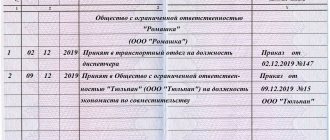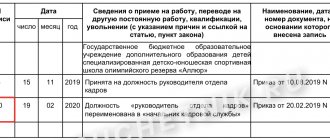Legislative framework for correct maintenance of labor documentation
The Ministry of Labor and Social Development of the Russian Federation has prescribed clear instructions for filling out all fields in the work books of enterprise employees.
The Government of the Russian Federation has developed and approved Rules for their maintenance and storage. The Instructions and Rules must be strictly followed by the HR department of each employer.
All entries in labor documents (books) are made in accordance with the Labor Code of the Russian Federation.
Article 66 The Labor Code of the Russian Federation obliges the employer to create a work book for each employee if he has worked for him for more than 5 days, and this position is the main one. The exception is employers - individuals who do not conduct individual entrepreneurial activities.
See the full text of Article 66 of the Labor Code of the Russian Federation below:
Information displayed in work books
According to part 4 of the Labor Code of the Russian Federation and 4p. Rules, data in the books must contain information about the employee, his position, transfers to other positions, dismissals, grounds for termination of working relationships, data on the employee’s successes, incentives, awards and punishments.
Information about official salary, bonus payments, allowances is not displayed in the work book . All cash payments are included in the collective agreement or labor acts, collective agreements. Entering information about wages and other payments is illegal.
Records of the employee’s temporary movements are not included in the labor document. They are registered in the employee’s personal card (No. T-2).
Change of labor obligations without changing department
Data on transfer to fill another vacant position in the previous structural unit must contain:
- serial number of the record itself;
- date of entry in the work book;
- entry “Transferred to position ___”, reason – paragraph of Article No. 72 of the Labor Code of the Russian Federation;
- registration data of the transfer order (number and date), seal (stamp) of the enterprise.
Changes in both labor obligations and structural unit
In the event of a change of employer and position, written approvals must be made. Recommended procedure if the initiator of the transfer is the employer:
- the manager of the host party sends a written request to the current employer. The request must contain information about the position being provided and the date of the proposed transfer;
- the current employer, having reviewed the request, must obtain confirmation from the employee;
- upon receipt of consent from the employee, the process of drawing up a confirmatory application for transfer is underway and sent to the personnel department of the employer enterprise;
- the corresponding fields in the work book regarding the termination of the working relationship are filled in, indicating the reason.
Recommended procedure in case the initiator of the transfer is an employee:
- a letter of resignation is written with the obligatory indication of its reason “In connection with the transfer to (name of enterprise) _____ to the position of ___”;
- the current manager must send a request to the receiving unit indicating the wishes of his employee;
- After confirmation, appropriate entries are made into the employment document regarding the employee’s dismissal.
The employee’s labor document must contain the following records of transfer (movement) to another position in another department:
- number in order of the entry itself;
- date of making entries in the work book;
- the entry itself “Dismissed due to transfer to (name of enterprise) position ___”;
- reason - paragraph 5, 77 of article “Labor Code of the Russian Federation”;
- number and date of the transfer order;
- seal (stamp) of the enterprise.
Dismissal by transfer, entry in the work book:
What to do if they do not issue a work book upon dismissal, and who should sign the work book upon dismissal - read here.
If the initiator of the transfer is a new employer
If a company is interested in hiring a specific specialist, it can send a petition to the organization requesting the transfer of the employee. In the letter, the potential employer invites the current employer to consider the possibility of a transfer under certain conditions. The letter contains the following information:
- Full name of the employee.
- Proposed vacancy and salary.
- Estimated hiring date.
This is also important to know:
What to do if you are not paid your salary upon dismissal and where to go
The current employer reviews the letter within the period established by the business rules (usually 5 working days) and makes a decision. If you agree, the corresponding visa will be stamped on the document. The employee who is offered a new position is informed in writing about the request received and receives his consent to the transfer or a reasoned refusal.
Important
If the issue is resolved positively, the responsible specialist sends a letter to the interested party confirming the possibility of the transfer and the employee’s consent to change jobs.
Changing a structural unit without changing job responsibilities
The transfer of an employee from one employer to another must be formalized as a dismissal by transfer, but not as a transfer. The work book must contain a record from the HR department about the dismissal of an employee from one organization and a record about hiring for a position in the order of transfer to another department.
A transfer (relocation) to the same position in another unit is completed as follows:
- serial number of the record,
- date of filling out the work book,
- the entry itself is “Dismissed due to transfer to department ___ for position ___”, the reason is paragraph 5, article 77 of the Labor Code of the Russian Federation,
- number and date of the transfer order,
- seal (stamp) of the enterprise.
Sample entry in the work book about dismissal in the order of transfer:
Entry in the work book about transfer to another organization - sample:
If an insert was used to make entries in the work record, then this should be reflected in the receipt and expenditure book for recording forms of work books and inserts.
An employee is dismissed by transfer: general rules for registration
As mentioned earlier, the transfer of an employee can be carried out either within the organization or to another employer. Only when moving to another enterprise is a record of dismissal from the previous one made.
The transfer can be made at the initiative of the citizen himself or at the initiative of the employer, but with the consent of the employee. By virtue of clause 6.1 of the Instructions, it is necessary to make a reservation in the labor manual about the exact order in which the transition is carried out.
There is no consensus among HR specialists on how to formalize a notice of dismissal: “Dismissed on such and such grounds” or “The employment contract was terminated on such and such grounds.” The Pension Fund allows both formulations, but in the Instructions all examples begin with the phrase: “Dismissed for such and such reasons.” Thus, both options can be used.
Also, do not forget that it is forbidden to correct or cross out anything in the labor report. All data is provided in full without any abbreviations. It is important to note that the Instructions do not oblige you to indicate the part number of the article. However, it is a by-law, and one must still be guided by the Labor Code of the Russian Federation. And part 5 art. 84.1 of the Labor Code of the Russian Federation requires full information to be entered: the clause, part and article under which the dismissal occurs.
After entering information about dismissal, the next block of the work book ends. A block is all records of the same employer. Below we will tell you how to close it.
Responsibility of employers and employers for violation of rules
According to the articles of the Labor Code of the Russian Federation, it is prohibited to refuse an employee to conclude a new employment agreement (contract) if he was invited to transfer. The ban is valid for one month from the date of dismissal (Article 64 of the Labor Code of the Russian Federation).
For refusal of employment, the Code of Administrative Offenses of the Russian Federation provides for a fine ( from 500 to 5 thousand rubles ) and possible disqualification of the head of the enterprise.
The previous employer is also responsible. An employee has the right to appeal violations in court and reinstate him to his previous position ( Article 394 of the Labor Code of the Russian Federation ).
No abbreviations or acronyms are allowed when filling out fields in the work book. All records are made only by authorized officials, certified by seals (stamps), signatures of the company’s managers and the signature of the employee himself. A record of an employee’s dismissal is made directly on the last working day. Remember, the period for issuing a work book upon dismissal is limited. You also need to know what to do if an employee does not come for a work book.
Legislative regulation
The legal relationship between an employee of an organization (firm, enterprise) and the employer is prescribed in the Labor Code of the Russian Federation. All the nuances of terminating industrial relations between employees and the management of the companies in which they work are also fully established here. In addition to the code itself, HR department specialists need to rely on the standards specified in the following documents:
- Decree of the Government of Russia No. 225 (2003), which specifies the regulations for the preparation and maintenance of records in work books.
- Ministry of Labor Instruction No. 69 of 2003. It contains detailed rules for completing documentation when transferring an employee to another place of work.
But any regulations reflect only standard “working” options for filling out documentation. Everything that cannot be attributed to typical cases is drawn up by HR specialists based on their vision, experience and understanding of the law:
- They are looking for information about similar cases that their colleagues have encountered.
- They use ready-made “samples” that are used by personnel officers everywhere.
The same can be said about registration of dismissal by transfer (clause 5 of Article 77): an entry in the work book must necessarily reflect the reason why the employee is relieved of his position.
Description of the procedure
When completing the procedure, all details must be observed.
First, the employer must be notified of the employee’s impending departure. This is done by means of a written notice written to the manager. In this case, compulsory work within 14 days may not be required, since this moment is entirely at the discretion of the employer. Although, of course, this option is not used often, because a replacement must be found to replace the departing employee.
With this type of dismissal, the new employer is obliged to hire this person within one calendar month. If this does not happen after 30 days, the employee has the right to go to court. Based on the results of consideration of the claim, two possible decisions can be made:
- The court will oblige the new employer to place the employee on staff. At the same time, certain measures may be applied to an employer who changes his decision regarding hiring a new employee by transfer, ranging from fines of up to 5 thousand rubles to disqualification.
- Reinstate the employee in his previous place - on the basis of Article 394 of the Labor Code of the Russian Federation.
Such unique “social guarantees” exist only with this method of changing jobs. For other types of dismissal, there will be no such preferences.
Incentives to change jobs
The main reason for an employee to move from his old place of work is to find a more profitable job elsewhere. The benefit may be financial or proximity to home, which will significantly save travel time, or a more convenient schedule. And the situations themselves in which dismissal is necessary can be as follows:
- The employee found a new place of work outside of his company. At the same time, the new manager gave his consent to enroll this person on the staff of his company.
- The employee wished to move to another division within the same enterprise.
- The management of the unit itself invited the person to transfer to their department.
- The organization is planning a restructuring, after which the division where the employee worked will be renamed or completely disbanded.
Depending on the chosen option for transferring an employee, the operation can be either internal (within one enterprise) or external. At the same time, it is important to know that an internal transfer of an employee from one place (position) to another is possible only with his written consent (Article 72 of the Labor Code of Russia).










